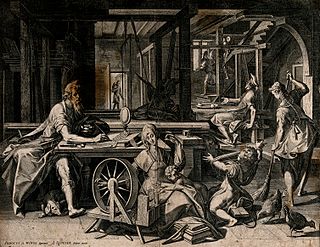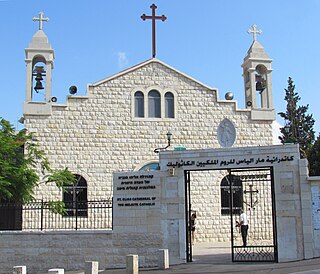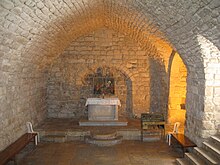
Nazareth is the largest city in the Northern District of Israel. Nazareth is known as "the Arab capital of Israel". In 2021 its population was 77,925. The inhabitants are predominantly Arab citizens of Israel, of whom 69% are Muslim and 30.9% Christian.
The Church of Antioch was the first of the five major churches of the early pentarchy in Christianity, with its primary seat in the ancient Greek city of Antioch.

The Nazarenes were an early Jewish Christian sect in first-century Judaism. The first use of the term is found in the Acts of the Apostles of the New Testament, where Paul the Apostle is accused of being a ringleader of the sect of the Nazarenes before the Roman procurator Antonius Felix at Caesarea Maritima by Tertullus. At that time, the term simply designated followers of Jesus of Nazareth, as the Hebrew term נוֹצְרִי, and the Arabic term نَصْرَانِي, still do.

The Annunciation, also referred to as the Annunciation to the Blessed Virgin Mary, the Annunciation of Our Lady, or the Annunciation of the Lord, is the announcement by the archangel Gabriel to Mary that she would conceive and bear a son through a virgin birth and become the mother of Jesus Christ, the Christian Messiah and Son of God, marking the Incarnation. Gabriel told Mary to name her son Immanuel, meaning "God is with us".

Priscilla and Aquila were a first century Christian missionary married couple described in the New Testament. Aquila is traditionally listed among the Seventy Disciples. They lived, worked, and traveled with the Apostle Paul, who described them as his "fellow workers in Christ Jesus".

The transformation of water into wine at the wedding at Cana is the first miracle attributed to Jesus in the Gospel of John.

The Melkite Greek Catholic Church, or Melkite Byzantine Catholic Church, is an Eastern Catholic church in full communion with the Holy See as part of the worldwide Catholic Church. Its chief pastor is Patriarch Youssef Absi, headquartered at the Cathedral of Our Lady of the Dormition, Damascus, Syria. The Melkites, who are Byzantine Rite Catholics, trace their history to the early Christians of Antioch, formerly part of Syria and now in Turkey, of the 1st century AD, where Christianity was introduced by Saint Peter.

Matthew 13 is the thirteenth chapter in the Gospel of Matthew in the New Testament section of the Christian Bible. Verses 3 to 52 of this chapter form the third of the five Discourses of Matthew, called the Parabolic Discourse, based on the parables of the Kingdom. At the end of the chapter, Jesus is rejected by the people of his hometown, Nazareth.

The Church of the Annunciation, sometimes also referred to as the Basilica of the Annunciation, is a Catholic church in Nazareth, in northern Israel. It is one of two claimants to the site of the Annunciation – in which angel Gabriel appeared to the Virgin Mary and announced that she would give birth to Jesus – the other being the Greek Orthodox Church of the Annunciation.

Mary's Well is reputed to be located at the site where, according to one Christian tradition associated with the apocryphal Gospel of James, Archangel Gabriel appeared to Mary, mother of Jesus and announced that she would bear the Son of God – an event known as the Annunciation. It has been further associated in the past with episodes from another apocryphal infancy gospel, the Infancy Gospel of Thomas.
Joseph Raya was a Lebanese-born Melkite Catholic archbishop, theologian, civil rights advocate.

Jish is a local council in Upper Galilee, located on the northeastern slopes of Mount Meron, 13 kilometres (8.1 mi) north of Safed, in Israel's Northern District. In 2021 it had a population of 3,154, which is predominantly Maronite Catholic and Melkite Greek Catholic Christians (63%), with a Sunni Muslim Arab minority.

The Greek Orthodox Church of St. Gabriel, also known as the (Greek) Orthodox Church of the Annunciation, is an Eastern Orthodox church in Nazareth, Israel. It is one of two claimants to the site of the Annunciation - where angel Gabriel appeared to the Virgin Mary and announced that she would give birth to Jesus - the other being the Catholic Basilica of the Annunciation.

Mensa Christi is a Roman Catholic church located in Nazareth, northern Israel.

The following outline is provided as an overview of and topical guide to Christianity:

Stephen is traditionally venerated as the protomartyr or first martyr of Christianity. According to the Acts of the Apostles, he was a deacon in the early Church at Jerusalem who angered members of various synagogues by his teachings. Accused of blasphemy at his trial, he made a speech denouncing the Jewish authorities who were sitting in judgment on him and was then stoned to death. Saul of Tarsus, later known as Paul, a Pharisee and Roman citizen who would later become a Christian apostle, participated in Stephen's martyrdom.

Melkite Greek Catholic Archeparchy of Akka is an Eastern Catholic diocese of Melkite Greek Catholic Church, directly subject to the Melkite Patriarch of Antioch. Its Cathedral episcopal see is St. Elijah Greek-Melkite Cathedral, in Haifa.
Melkite Greek Catholic Archeparchy of Sidon is a diocese of the Melkite Greek Catholic Church suffragan of the Melkite Greek Catholic Archeparchy of Tyre. In 2010 there were 32,000 baptized. It is currently governed by Archeparch Elie Bechara Haddad, BS.

The Greek Catholic Church of the Annunciation is the parish church of the Melkite Greek Catholic community in the city of Nazareth in northern Israel.



















